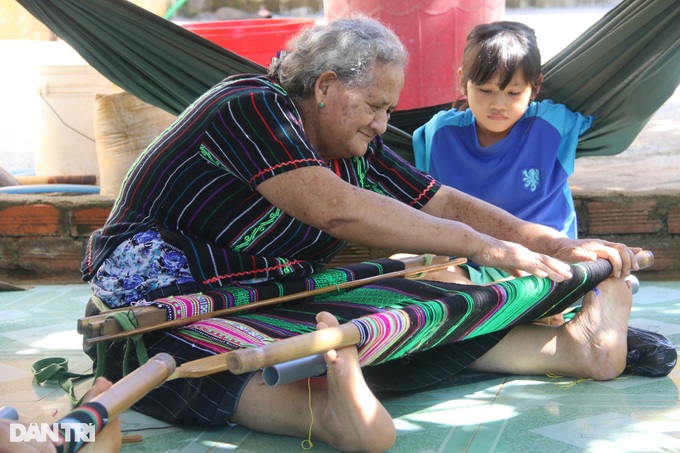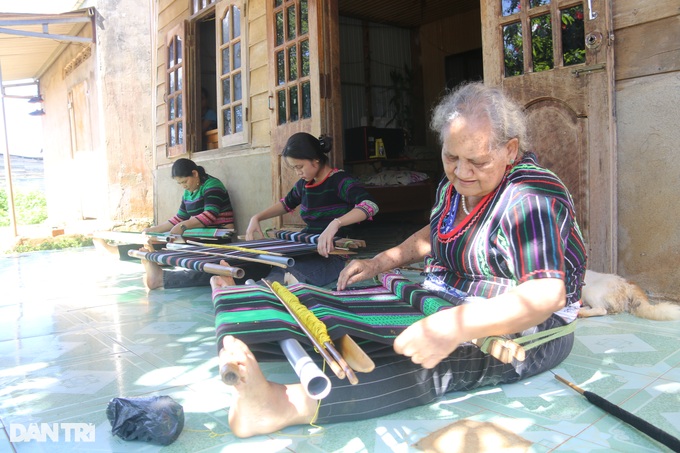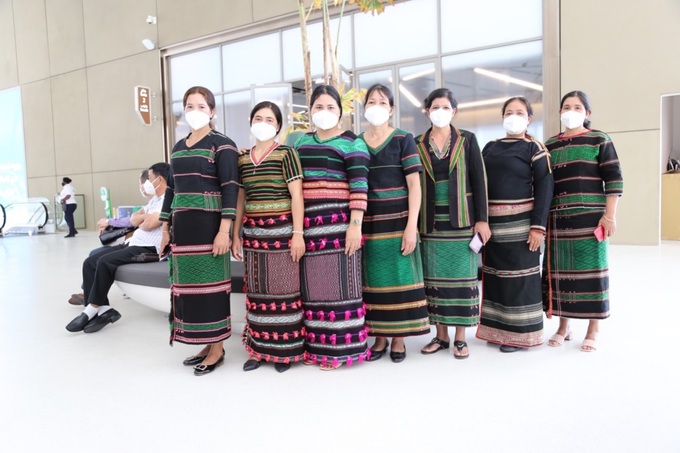Compass Travel Vietnam
Three generations of Ma people preserve the value of brocade in the Central Highlands
It is rare for any Ma family to keep brocade weaving like Mrs. H’Bach’s family. For more than half a century, weaving has become an invisible thread, connecting three generations, and contributing to preserving the culture of the Central Highlands.
Three generations of keeping the weaving profession
A month ago, the community-based tourism model was implemented in Bon N’Jieng, Dak Nia commune, Gia Nghia city (Dak Nong province) which helped Ms. H’Bach have more income from brocade weaving.
The delegations who came to Bon N’Jieng all chose to buy some brocade sheets as souvenirs, so the fabric woven by Mrs. H’Bach’s family is also very “expensive”.

Mrs. H’Bach (73 years old) said that from the age of 10, her mother sent her neighbor to teach her how to spin yarn, go to the forest to get leaves, turmeric, and melaleuca to dye the thread.
Going to work during the day, sitting at night on the loom, over the past 60 years, this woman has mastered weaving techniques, becoming one of the skilled artisans of brocade weaving in Dak Nong.
In the way of thinking as well as customs of the people, all Ma girls must know how to weave. So even when her daughter was unmarried, Mrs. H’Bach taught Ms. H’Binh the craft of weaving and instilled in her love for the loom and thread of the people.

“For the Ma and other indigenous peoples, women and girls must know how to weave cloth. In their youth, brocade weaving is used as an offering to ask for a husband. After getting married, then weaving cloth to sew clothes. .
According to the 73-year-old female artist, teaching brocade weaving is not simple, one day or two. Many brocade panels take years to weave. The cloths are woven with natural materials with many unique patterns, sometimes priced at the price of a male buffalo. The Ma people preserve and preserve them as family treasures.
Out of poverty thanks to brocade
“There was a time when brocade sheets became a measure of the wealth and poverty of each Ma ethnic family. Poor people only had blankets to cover, rich people, in addition to brocade blankets, used this fabric to sew loincloths. Dresses, bags, scarves Ma women want to have a husband, they have to hand-weave some brocade cloth for the husband’s family, if there is a house that can’t weave cloth, they have to bring valuable belongings in exchange.
Today, although no one exchanges buffalo or cow for a brocade blanket, but for the Ma ethnic group, brocade still has a great meaning and role in our lives” – Ms. H’Binh, daughter of Ma Mrs. H’Bach said as she quickly put her hands on the loom.

According to female artist H’Binh, society develops, Ma girls do not have to sit by the loom every day, because they can easily buy themselves a blanket and a dress for only 1 million to 3 million dongs. But there are still many people looking to buy handmade brocade, thereby creating a solid foothold for the Ma ethnic brocade.
As the leader of the cooperative group of traditional brocade weaving in Dak Nia commune, Ms. H’Binh is also a witness to the “promotion” of Ma brocade. She is proud when the traditional patterns of the nation, the natural colors of the mountains and forests are put into fashion products by designers.

“On average, a week each artisan can weave a cloth of size 50 cm x 150 cm, with a selling price of 1.5-3 million dong. Compared with farming work, brocade weaving is lighter, bringing a lighter weight and a better quality of life. In particular, brocade woven everywhere is ordered there. Many brocade panels are ordered by fashion designers, from which brocade also has a higher application value.” artist born in 1987 said.
According to Ms. Binh, although it is no longer worth the fortune as in the past, in the Ma’s opinion, brocade panels still hold a great meaning. Therefore, the blankets and dresses made of this traditional fabric are carefully stored by the grandmother and mother, waiting for the new rice celebration, the rain prayer ceremony or the house with noble guests to use.
Understanding that meaning and value, artisans H’Bach and Ms. H’Binh are still deeply devoted to weaving, ready to teach those in need. In which, Tran H’Nhan (SN 2006, daughter of Ms. H’Binh, a student at N’Trang Long Ethnic Minority Boarding High School) is considered the 3rd generation, the generation that continues the family’s weaving tradition. .
After 3 years, H’Nhan’s small hands have woven dozens of fabrics. Some panels sold for several million dong.

“For many years now, Dak Nia commune has been chosen as the locality to open brocade weaving classes, I was invited to teach. I think that, if you appreciate the brocade panels, Ma culture can reach further. more to reach the international community,” said Ms. H’Binh, recalling her pride in becoming one of the 7 brocade weavers of Dak Nong to attend the Vietnam National Day in the United Arab Emirates. Reunification at the end of 2021.
Three generations of Ma people preserve the value of brocade in the Central Highlands
vinlove.
Source: vinlove









